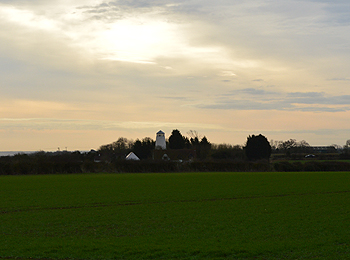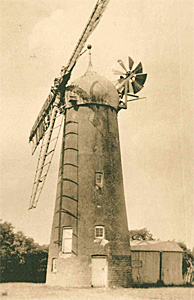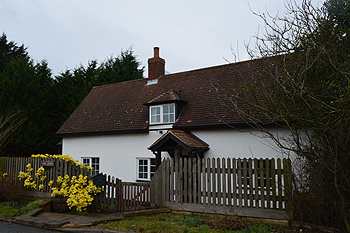Thurleigh Windmill

The old windmill from Church End, January 2015
Today the remains of Thurleigh windmill form part of an attractive house. Neither the mill nor the mill cottage are shown on the inclosure map for the parish of 1805 and so must post-date in [ref: MA47/3]. The mill was listed by the Ministry of Works in May 1952 as Grade II, of special interest. It is built of red brick and partly cemenet rendered. No cap or sails survive but the windshaft, brake-wheel, some gears and the cradle do. The former miller's cottage was listed by English Heritage in August 1983, also as Grade II. It is built of colour washed brick and comprises one storey and attics beneath an old clay tiled roof. The original structure had three rooms downstairs.
Despite the surviving mill being a 19th century structure it is known there was a windmill in the parish as early as 1279, as noted by J. Steele Elliott in his gazetteer of Bedfordshire windmills in Volume 14 published by Bedfordshire Historical Record Society in 1931, quoting the Hundred Rolls for the county. Windmills were introduced into England about a century before this.
In 1325 An Extent of the Exchequer, also mentioned by Steele Elliott, also noted a windmill, which was worth twenty shillings per annum. A Mill Field is recorded in 1708 [ref: ABE2, page 357]. The medieval windmill may have stood quite close to the village – Steele Elliott records that 200 yards up Keysoe Road from its junction with the High Street, and forming part of the garden of a cottage, was a partly moated mound still known in his day as Windmill Hill. This mound was 66 feet across and 5 or 6 feet higher than the surrounding land. The moat round the mound was around 9 feet wide and 5 feet deep and always contained water. He records that in 1808 a post mill stood thirty yards closer to the road: "It was, I understand, of a similar type to the one at Riseley, but without the ground floor room below the mill, being carried on four lean-yo timber supports. The sails, when working, came near to the ground, and in one instance struck a man on the head and scarred him for life".

Thurleigh Windmill, about 1930 [ref: PU261/78, fig.28]
Steele Elliott records the height of the surviving windmill, at Scald End, as 60 feet. There were five floors above the ground, including the bin floor. The width of the base is 22 feet and the walls are two feet thick. The top of the tower is 14 feet across and the brickwork 18 inches thick. One sail was missing by 1931. Steele Elliott reckoned the mill to have been erected about 1890 to replace an earlier mill that had blown down. He records that it was last worked in 1917 and had latterly been fitted with steam power to augment the wind. There were two pairs of grinding stones.
The miller about 1800 was John Ward. Thomas Jefferies was miller in 1848, his widow Mary Ann in 1869. Their son Benjamin is recorded in a directory of 1877 and William Hebbes in Kelly's Directory for 1898, 1910 and 1914.
The Rating and Valuation Act 1925 legislated that every building and every piece of land in the country was to be assessed to determine its rateable value. Thurleigh, like much of the county, was assessed in 1927. The valuer visiting the mill [ref: DV1/C73/11] found it owned and occupied by H. Walker and "disused" (M. H. Walker and Sons are listed as millers in Kelly's Directory for 1920). It stood in just under half an acre of land and the cottage comprised a parlour, a living room, a kitchen, a scullery and an engine house. The valuer noted: "old mill seldom used, 2 pairs stones". Of the cottage he commented: "Very low" and bedrooms at back bad". Sharing the site were farm buildings including a stable, two cart sheds, two pigsties, another cart shed, a loose box, a barn and a hovel. In 1989 planning permission was sought to extend and alter the mill to form a dwelling [ref: BorBTP/89/1570/LB].

The Mill House, January 2015